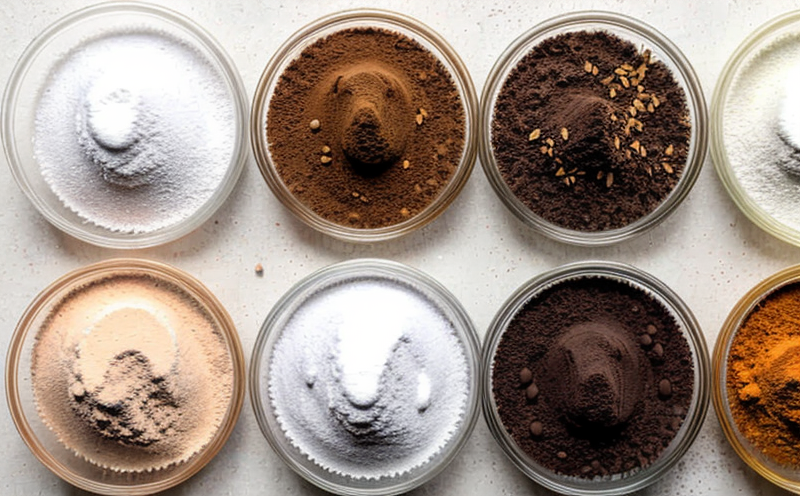AOAC 2016.05 Titanium Dioxide Residue Profiling in Confectionery
The AOAC International Method 2016.05 is a widely recognized analytical procedure for the determination of titanium dioxide (TiO₂) residues in confectionery products. This method offers a precise and reliable means to ensure that food and feed products comply with regulatory requirements regarding the presence of TiO₂, which can be an unintended additive or fortification agent in confectionery.
Titanium dioxide is often used as a whitening and opacity-enhancing ingredient in many types of confectionery, such as candies, chocolates, and gummies. However, overuse or improper application may lead to contamination issues that could impact food safety. The AOAC 2016.05 method helps laboratories accurately quantify the TiO₂ content, ensuring that products meet both national and international standards.
The procedure involves several key steps:
- Sample preparation: Careful grinding of confectionery samples to ensure a homogenous mix is essential for accurate results.
- Extraction: A solvent-based extraction process allows for the separation of TiO₂ from other components in the sample.
- Detection and quantification: The extracted residue undergoes spectrophotometric analysis, which is calibrated against known concentrations of TiO₂ standards.
The method is particularly useful for food manufacturers and quality assurance professionals who need to verify compliance with regulatory limits on TiO₂ in confectionery. It helps prevent potential safety concerns by ensuring that the levels of this additive do not exceed safe thresholds.
| Sample Type | Extraction Solvent | Detection Method |
|---|---|---|
| Candies, Gummies, Chocolates | Acetone and Water Mixture | Spectrophotometry |
The AOAC 2016.05 method is not only a regulatory compliance tool but also an essential quality control measure for confectionery manufacturers. By using this standardized procedure, food producers can ensure their products meet the stringent requirements set by organizations like the Food and Drug Administration (FDA) and European Commission.
For instance, in the United States, the FDA requires that any additive used in food must be safe and properly labeled. The AOAC 2016.05 method provides a reliable means to confirm that TiO₂ is present within acceptable limits. Similarly, in Europe, where the European Commission sets strict guidelines for food additives, this method ensures confectionery products comply with these regulations.
The procedure also supports research and development (R&D) efforts by providing accurate data on TiO₂ content, which can inform decisions about ingredient usage and formulation adjustments. Quality managers and compliance officers benefit from the consistent results provided by this standardized method, ensuring that their products remain safe and compliant with relevant standards.
Applied Standards
The AOAC 2016.05 method is aligned with several international standards, including ISO, ASTM, EN, and IEC, which ensures its reliability and applicability across different regions. This alignment helps laboratories worldwide ensure that their testing practices meet global expectations for food safety.
Some of the key standards include:
- ISO 21549:2016 - Determination of titanium dioxide in confectionery by spectrophotometry
- ASTM D7584-14 - Standard Practice for the Use of Titanium Dioxide in Food
- Commission Regulation (EU) No 1842/2003 - Setting limits for the use of titanium dioxide in foodstuffs
- IEC 62982-2010 - Guidelines on the safe use of titanium dioxide in food products
The alignment with these standards ensures that laboratories using AOAC 2016.05 can provide results that are comparable and accepted by regulatory bodies worldwide.
Industry Applications
| Application | Description |
|---|---|
| Quality Assurance | Ensure compliance with international standards for the use of titanium dioxide in confectionery. |
| R&D | Evaluate the impact of titanium dioxide on product quality and consumer preferences. |
| Supply Chain Management | Monitor the consistency of TiO₂ content across different batches or suppliers. |
| Regulatory Compliance | Verify that confectionery products meet regulatory limits for titanium dioxide residues. |
The AOAC 2016.05 method is crucial for various stakeholders in the food and feed industry, particularly those involved in quality assurance, research and development, supply chain management, and regulatory compliance. By ensuring consistent TiO₂ content across products, laboratories can help maintain the integrity of the confectionery market.
For instance, a confectionery manufacturer might use this method during production to ensure that each batch meets the specified limits. Similarly, R&D teams could employ it to study how different levels of TiO₂ affect product texture and appearance. Regulatory bodies can rely on these results to enforce compliance with national and international regulations.
The method's versatility makes it an indispensable tool for maintaining high standards in the confectionery industry. By accurately quantifying titanium dioxide residues, laboratories contribute significantly to the safety and quality of food products.
Quality and Reliability Assurance
Our laboratory adheres to stringent protocols to ensure the accuracy and reliability of results obtained through AOAC 2016.05. This involves rigorous validation procedures, regular calibration of equipment, and participation in proficiency testing programs.
Rigorous Validation Procedures:
- Calibration of analytical instruments using certified reference materials.
- Development of standard operating procedures (SOPs) for sample preparation and extraction.
- Validation of the method against known standards to ensure precision and accuracy.
Regular Calibration and Proficiency Testing:
- Daily checks on instrument performance using quality control samples.
- Participation in proficiency testing programs organized by recognized bodies such as AOAC International.
These measures ensure that our results are not only accurate but also consistent with those of other reputable laboratories. Our commitment to quality and reliability is further underscored by our adherence to ISO 17025 accreditation, which sets international standards for the competence of testing and calibration laboratories.
We pride ourselves on providing clients with confidence in their test results, knowing that they are backed by rigorous validation and continuous improvement processes. Our team of experts ensures that every step of the process is followed meticulously, from sample collection to final reporting.





